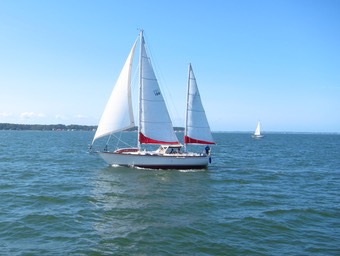Travel 2020-2021
A little touch-up
Rust never sleeps. Also. Rock and roll will never die. But that’s another story.
We had two problems leading to water on the engine (and rust.) One of the deck drain fittings failed, leaking rain water over everything. This was an amazing amount of water. All the snow-melt from the port side of the boat ran down through the broken fitting under the lazarette and onto the engine. And onto the top of the center fuel tank. It filled the bilge above the level of the fuel tank, floating the remaining diesel fuel out of the tank. While catastrophic, by the end of the summer, I eventually pumped the remaining diesel out of the center fuel tank. It’s now filled with ~100 gallons of snow melt and a little antifreeze.
The second problem was smaller. The exhaust anti-siphon loop got a tiny bit of crud in the little flapper valve. Crud is rare in the raw water intake, but it’s not impossible. There are calcium deposits and and a zinc that can leak large particulate into the raw water system. The bit of crud in the anti-siphon meant it leaked raw water in the engine room. The big, bronze anti-siphon comes apart with pliers. Inspection and cleaning is all that’s required to fix it. But. Raw water rusting things up.

In this picture of Mr. Lehman, I’ve removed the aft air cleaner, pushed a rag into the intake, and scraped as much loose paint as I could with a soft wire brush.
Theoretically, we should etch with some solvent, prime, and paint.
But.
For now, I’m going to cheat.
A can of Rust-Oleum IH Farm Implement Red will probably do about as well as a really professional masking, priming and painting exercise. The exhaust manifold is a giant cast-iron block. The rust can (eventually) eat through the metal, but I expect it would take decades.

We are dealing with exhaust gasses here, so a little care seems prudent.
(And a new carbon monoxide detector will also be a good idea.)
The color doesn’t match the original red perfectly. The folks at American Diesel in Kilmarnock told us not to spend a lot of money buying the Ford-branded engine paint. Rust-Oleum was perhaps better, and the Farm Implement red was a good match.
CA has a bunch of places that need additional touch-up. We’ll be masking and painting some more.
The “use in a well-ventilated area” doesn’t fit well with spraying paint inside the engine room. This means we like to paint just before we leave the boat. We’ll be touching up a little at a time.
Rust never sleeps.
It’s going to look like this
All the supports are inside the tank, screwed into the aluminum.
They’re more-or-less lined up, and they sit about as level as anything in a boat can sit. Which is to say, not level enough for billiards, but level enough that the olive doesn’t get knocked out of my martini glass.

Here are cardboard templates for the three parts of the upper bunk for the 35 gallon bladder.
The bottom 15 gallon bladder is back-ordered, giving me more quality to paint.
Ideally, I can get two coats on between Saturday and Sunday. Unless it’s so cold Saturday that we don’t want to go out to the boat.
Measuring the space (yet again) I see that it’s a very, very tight fit for these two bladders. I don’t think the bottom bladder can be filled completely because of the narrowness of the V.
We’ve never been able to use this tank. So a ¾-full 15 gallon bladder and a 35 gallon bladder is vastly better than what we have now.
For the fresh-water systems, we want to clean the starboard tank, and start tearing apart the port tank.
We can’t do this until we get the sails out of the saloon. Doing a job this big only on weekends is challenging. But. When I stack this against other people’s life challenges, this is hardly even worth complaining about.
When the bladder arrives, then we can clean it. Imtra has a cleaning procedure that’s very important.
Before using your water tank for the first time, partly fill the tank with warm water (122 ̊F/50 ̊C) and a 1% solution of mild detergent. After a few minutes, rinse with clear water and fill again with water treated with chlorine tablets (follow package instructions for a 5% concentration). Empty after 2 hours and carefully and thoroughly rinse with clear water. This procedure should be performed with the system fully installed so that all the piping undergoes the same treatment.
Maybe we’ll do this on deck where we can drain the bladder with gravity instead of the boat’s fresh-water pump.
They recommend cleaning every 6 months. Perhaps this means that I want to put a drain cock down in the bilge to let gravity drain the tanks during cleaning?
For long-term storage, they recommend 10% chlorine in a partially-filled bladder. This seems to be an insane amount of chlorine. We suspect this is really 0.1%. We suspect this is a good idea for the other tanks, also, and we’re going to try and remember to do this. It does mean keeping a close eye on water levels to judge how many chlorine pills to get to 10% chlorine levels.



